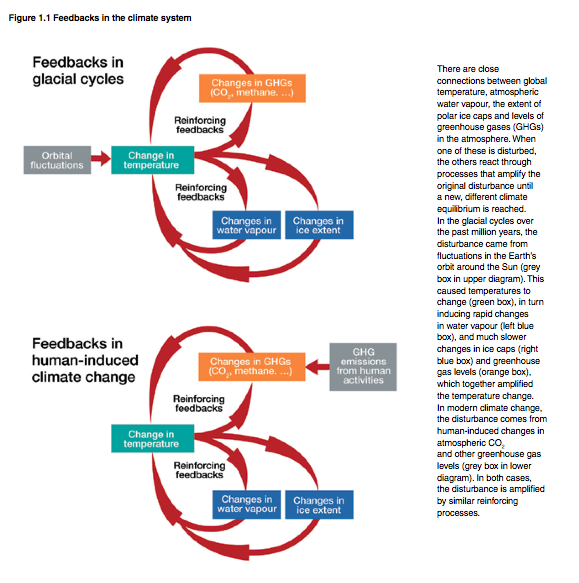Systems Thinking, Lumpers and Splitters, Systems Education
One of Eli's favorite figures comes from the Australian Academy of Sciences and neatly captures the way in which greenhouse gases can be both an initiator and a feedback to global climate
Part of the problem many scientists have explaining such to the average family member and students is that physical science and engineering STEM folks tend to be splitters, aka reductionists, tear something down to the bare bones to understand how it works.
With a subject that links many areas and ideas together, it simply takes too long to bring folks up to speed on enough parts of the problem that they (to use a 60s word, ask grandpa) can grok the thing.
Peter Mahaffy and colleagues at the King's Center for Visualization in Science are lumpers, establish the connections to teach about the entirety, then learn about the individual parts. They have a chemistry centered article in Nature Sustainability on Systems thinking for education about the molecular basis of sustainability
The primary activities of chemistry involve analysing, synthesizing and transforming matter, yet insufficient attention has been paid to the implications of those activities for human and environmental well-being. Since a core element of addressing sustain-ability challenges requires attention to the material basis of society, a new paradigm for the practice of chemistry is needed. Chemistry education, especially gateway post-secondary general chemistry courses, should be guided by an understanding of the molecular basis of sustainability. A Systems Thinking in Chemistry Education framework illustrates one way to integrate knowledge about the molecular world with the sustainability of Earth and societal systemsEli, a splitter to the bone, nonetheless sees great advantages of this approach, not only for climate change but for other issues which impact on the world in general. There are lots of great points and images in this paper. They have a great map that brings together the systems involved in the carbon cycle







6 comments:
On YouTube one can find dozens of explanations in Ted Talks, one-off presentations, debates, etc. Some of them clearer than the one in this post, some of them just as elaborate.
From the various audience reactions, it seems as though the inputs and outputs and even the interactions are adequately explained. Everybody seems to get it.
Until the values of the elements of the various pieces of the puzzle, expressed as parts of an equation, are specified, it doesn't resolve much.
If atmospheric sensitivity is low, things are okay. If atmospheric sensitivity is high, things are not okay.
That's much simpler than your diagram.
And when you “plan” around an indefensibly low atmospheric sensitivity (say, 2.1 K with a safety margin of .4 K), you’re going TOO simple.
Now some, not Eli to be sure might point out that given the large amount of really good analyses of each of those bubbles, and the really large numbers of folk who do not understand any of it, including Tom, perhaps a new approach emphasizing connections might be useful
Rabbit, there are very few, well, none of these thought bubbles that are difficult to understand. Their jellyfish nature derives from the total number, not complexity.
I was doing system models in the early 1990's. Around 1993, I helped organize an industry consortium to prepare a dynamic system model for Arctic ice breaking LNG carriers. Later I advised a few engineering graduate students on how to lay out flow diagrams and program the modules for system models intended to optimize mega developments in several countries, in which we had to take into account human response to our actions.
The idea that you discovered complex models and that engineers don't understand the concepts may apply to mom and pop engineers or to shops doing very unsophisticated modeling. The problem I see is that you have such a limited view of the full system that you sit there thinking California's efforts to control the climate are going to succeed.
Uncle Tuvalu, regardless of his implied destination, always lands in Venezuela.
Post a Comment